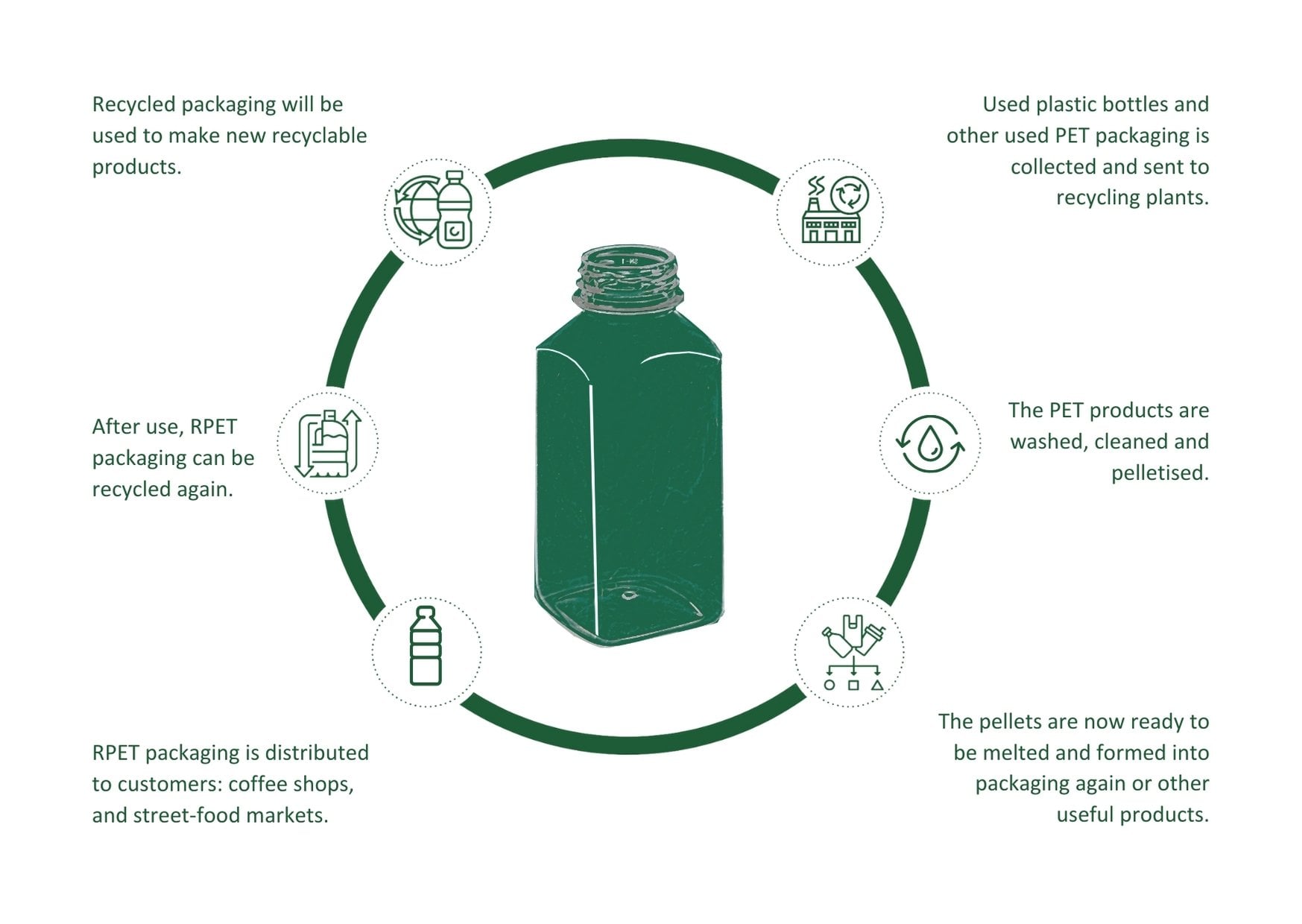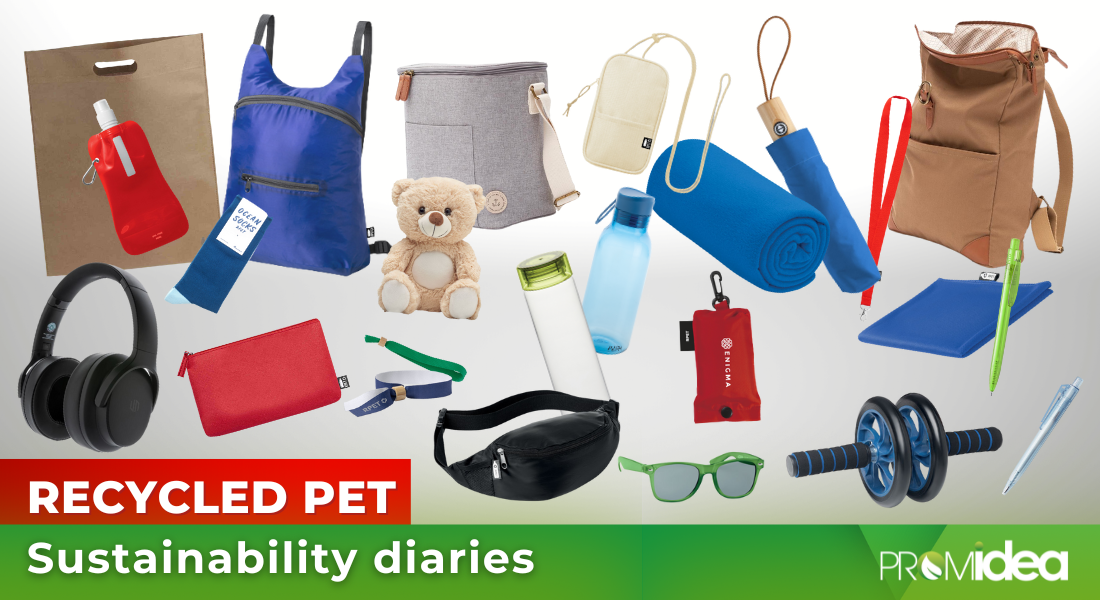“Our commitment is not only to be leaders in CSR matters within our industry, but also working hand in hand with our clients for a better and more sustainable future. Our mission is to deliver 100% safe and compliant premiums that deliver high ROI to our clients and bring a smile to their consumers.” PROMIDEA GROUP
Starting from the above affirmation we can say that sustainability is an important sector of our growth and a part of our organization that aims to help other companies to promote and sustain a healthier way of living by promoting eco-friendly products that have the power to change the mindset of the consumer.The healthier our ecosystems are, the healthier the planet - and its people. Encouraging businesses and consumers to recycle and reduce waste is equally important, as is supporting the promotional market industry to move towards more sustainable patterns of consumption.
PET is a very versatile and practical plastic. But how can we make this often single-use plastic more sustainable and less damaging to the environment? By introducing the Recycled Pet as a sustainable material. The demand for recycled content, such as R-PET around the globe is on the up. Driven by building pressure to deliver more sustainable ways of living and reducing environmental impact, this trend shows no signs of abating.
Definition:
The PET-Recycling Switzerland (PRS) association calls it “the superlative recyclate”. R-PET stands for recycled polyethylene terephthalate (PET). Virgin PET plastic, which is made from oil and petrochemicals, can be recycled into rPET. The plastic content in rPET has been recycled, so the material is produced without exhausting natural resources. In the recycling process, plastic is collected, cleaned and remade into products. Through reuse and a minimum of 24% reduction in carbon emissions during production, rPET can be considered a more sustainable choice. Technically, anything made from PET can be replaced with rPET
Choosing rPET helps create a circular economy by keeping these precious materials that have already been extracted from the earth in circulation. It supports the recycling industry and the companies that are embracing change. It saves energy, resources, and rescues these plastics from landfills where they can take thousands of years to break down.
The great thing about PET is that it is 100% recyclable, and it can be recycled repeatedly. Once the PET plastic has been recycled, it is referred to as rPET. Collected and sorted, it’s transported to ‘the recycling plant, where the material is cleaned and chopped up into small flakes. The flakes are then melted and made into pellets or fiber. Once processed, the recycled plastic can be used to make new plastic bottles or other items.
Plastic Recycling process : Step by Step : Plastic recycling is broken up into a few distinct steps. Generally these steps remain the same for most types of recycling facilities, but certain steps can be combined or omitted in some situations.
Collection - Sorting - Washing - Resizing - Identification and Separation - Compounding

What is rPET used for?
Even though PET is highly recyclable, it cannot always be recycled back into its original form. This is particularly the case for food-grade PET. It can be very difficult to clean the recycled plastic sufficiently to pass the high standards for food-grade plastics.
The color of the plastic can also impact the end-use. For example, clear and light plastic bottles are more likely to be made into new water bottles. Brown or green bottles are made into polyester fiber and fabric.
RPET can be used to make many different products in addition to being made into new plastic bottles. Common products include activewear, outdoor gear, bedding, and even stuffing for toys or pet beds. Anything made of polyester, which covers many everyday items, can use recycled PET.
Over the last 10 years more and more products have begun to be produced using recycled plastics. The opportunity for more and different types of recycled plastic products is nearly endless. The amount of recycled plastic products is ever increasing. This is a positive sign that people are becoming more environmentally aware of the negative impacts of plastics and benefit of recycling them.
Items that are made using rPET include:
- New Plastic bottles OR New PET containers;
- Food containers like smoothie/juice takeaway cups;
- Fiber for the inside of pillows, duvets, sleeping bags and others;
- Fiber for roof insulation or automotive parts;
- Polyester carpet fiber;
- Sweaters and fiberfill for sleeping bags and winter coats
- Industrial strapping
- Electronic gagets;
- Recycled clothing like:
- Yoga or activewear (T-shirts, underwear, athletic shoes and more)
- Swimwear
- Outdoor and travel gear (sweaters, winter coats)
Why should you choose rPET?
Although reducing the amount of plastic we as a society use has significant benefits, keeping plastic already produced in circulation is also extremely important. Recycling PET may not solve all our problems, but there are many good reasons to choose recycled PET over virgin PET.
- By choosing to buy recycled PET, you support the recycling industry and helping to create a market for recycled plastics.
- Buying products from companies that use rPET is like using your power for good. By doing so, you are voting with your dollars and supporting businesses that embrace sustainable practices and drive innovation.
- Using rPET removes the requirement for extracting virgin materials, thus reducing the energy consumption and carbon footprint.
- rPET uses plastic waste that would otherwise end up in a landfill or, worse, polluting the environment. When left in landfills, plastics can take thousands of years to break down. When they do break down, they will tend to break into smaller pieces that can do even more harm if released into the environment.
How to indentify items made from rPet?
rPET plastic can be identified by the symbol associated with it which can easily be spotted on the packaging material, often at the bottom. Look out for a triangle with a 1 in the middle. This is called a resin code, of which there are seven. Many brands and retailers will also make this disclaimer on their packaging often stating how much recycled content has been used (e.g. 100% or 30-70%). Some companies prefer to use the terminology, ‘post-consumer’ recycled PET.
Although PET and R-PET they share the same chemical compounds, there is a clear difference between PET and rPET. Rather than viewing all plastic as the same, more awareness is needed for consumers to be able to clearly differentiate between plastic types and, more importantly, to identify a more sustainable plastic.
Reducing your use of plastic is best, but recycling your plastic whenever possible is the next-best solution Do you want to align to a more sustainable promotional industry? Check out what Promidea can do for your brand. Together, we can invest in our planet. By choosing to promote products made from recycled plastic, you, as a company, have the power to bring change. Ultimately your consumer will play the biggest role in plastic recycling and the health of the world.
Source:
https://environment.ec.europa.eu/research-and-innovation/science-environment-policy_en
https://www.liveabout.com/recycling-polyethylene-terephthalate-pet-2877869
https://www.preventedoceanplastic.com/pet-and-its-eco-friendly-alternative-rpet/
https://www.plasticexpert.co.uk/pet-recycling/
https://naturalsociety.com/recycling-symbols-numbers-plastic-bottles-meaning/

